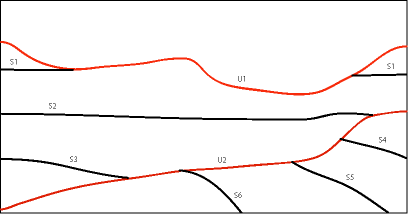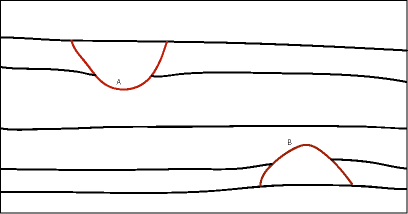|
<< Click to Display Table of Contents >> Stratigraphic Frameworks (Oil & Gas only) |
  
|
|
<< Click to Display Table of Contents >> Stratigraphic Frameworks (Oil & Gas only) |
  
|
A stratigraphic framework can be used to work out the geologic history of the area, to locate depositional environments and ecologies, and to understand the distribution of rock attributes. The stratigraphic framework is a group of sequences. Each sequence is composed of a set of conformable surfaces bounded by unconformities.
The identification of unconformities is the crucial first step in creating a stratigraphic framework. They are typically known from previous studies or from the interpretation of geologic data. Unconformities are most easily identified on cross-sections by their angular relationships with other surfaces. Typically unconformities in cross-sections appear as continuous surfaces against which other surfaces terminate. Unconformities that are concordant with surfaces above and below can be difficult to recognize on cross-sections; however, they usually can be grouped with that sequence in the stratigraphic framework.
Conformal surfaces generally do not exhibit angular relationships with surfaces other than unconformities. In some situations, conformal surfaces within a sequence may merge due to pinchouts. After all of the unconformities have been identified, all of the interleaving surfaces will belong to sequences. In the diagram below, there are two unconformities U1 and U2. The remaining surfaces are grouped into two sequences; sequence one with S1, S2, and S3 and sequence two with S4, S5, and S6. Some surfaces may not be conformal with other surfaces within a sequence and are not unconformities, these non-conformal surfaces need to be gridded independently of the conformal surfaces in the sequence.
When conformal surfaces intercept an unconformity, two possible relationships are possible. Truncation is where the unconformity truncates (erodes) the conformal surface from above, as shown in the relationship between unconformity U2 and surfaces S4, S5, and S6. Baselap is where the base of the conformal surface laps onto the unconformity, as shown in the relationship between unconformity U2 and surfaces S2 and S3.

In situations where the sequence contains a surface of limited extent that laps or truncates surfaces within the sequence, the surface is termed a special, non-conformal member of the sequence. For example in the diagram below, a stream channel may represent a localized erosional event. The surface of the bottom of the stream (A) may truncate surfaces beneath it and is considered a special surface. Another example would be a reef, the surfaces above the base of the reef may truncate against the top of the reef. In this case the top of the reef (B) would be termed a special surface.

When the surfaces in the stratigraphic framework have been identified and grouped into sequences and unconformities, the next step is to determine how to grid each surface. Unconformities that are not concordant with the sequence and special surfaces can be gridded directly. The conformal surfaces within a sequence could be gridded directly; however, this will not use all of the data available for the surface since they are conformal with other surfaces that may contain additional information. If another conformal surface has more extensive data available to be gridded, this control surface can be used to grid the conformal surface by calculating the isochore grid between the two surfaces. The isochore grid can then be added or subtracted from the control grid to generate the conformal grid. The new conformal grid will then also reflect the more extensive data from the control surface. In areas where there are pinchouts, the isochore grid is limited to positive values only. Within each sequence at one surface must be designated as a control surface to build the conformal grids.
After the surfaces (datasets) and relationships for a stratigraphic framework have been specified, the grids for the datasets can be created using the steps below.
1.Build a grid for each surface that is to be directly gridded (unconformities and special surfaces).
2.For all the conformal surfaces in a sequence use the isochore method and control surface to create the grid.
3.Excluding special surfaces, starting at the bottom perform baselap and truncation as necessary.
4.Starting at the bottom perform baselap and truncation on the special surfaces and the surfaces they affect.
For a detailed discussion on stratigraphic frameworks see:
Jones, Thomas A., 1986, Contouring Geologic Surfaces with the Computer, Kluwer Academic Publishers, Massachusetts, USA.